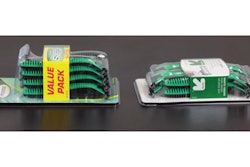The Association of Postconsumer Plastic Recyclers has released the Final Report of the Sleeve Label Working Group detailing recommendations the packaging industry can use to mitigate the impact of sleeve labels on the recycling of PET bottles. Formed in June of 2013, the APR Working Group represents all segments of the recycling industry and label supply chain, including PET reclaimers, brand owners, material suppliers, equipment vendors, and testing labs. Their primary focus is the ever growing technical issues associated with recycling containers with full-wrap shrink-sleeve labels.
“Recyclers were seeing more and more containers with full-wrap shrink-sleeve labels contaminating their material,” says John Standish, Technical Director of APR. “We formed a group to clearly identify steps that would allow brand owners to take advantage of these labels without creating a negative impact on the quality of the rPET stream.”
“Unfortunately, these labels serve as a great marketing tool, but they essentially render the container non-recyclable,” says Byron Geiger, President of Custom Polymers PET, and chairman of the APR Technical Programs. “Sorting technology was unable to identify the resin type of the container if it had a full-wrap label, thereby not separating it out appropriately, resulting in a contaminated stream of material. It was a significant problem.”
Key recommendations of the Working Group include:
- Employ sleeve labels that will float in water and separate from PET flakes in a sink/float material separation step.
- Employ printed labels where the label inks do not stain PET flakes in the wash/rinse step.
- Use APR’s Critical Guidance Document for Shrink Labels for PET Bottles as a comprehensive laboratory test program to assess the impact of a label on recycling PET bottles.
- Where possible, use a sleeve label that leaves at least 20% of the PET bottle surface area exposed. This will allow the most accurate auto-sortation by the broadest range of installed color sorters.
Although the problem is not completely solved, Standish points out that several label manufacturers have worked with the APR to create label stock that meets APR guidelines for removal of the labels in the wash system, which reduces the problem. “While we have a ways to go, the market is responding and working with APR to create guidelines that provide for the continued use of a full-wrap label that meets the needs of the recycler. As the market evolves, we are hopeful more and more companies adopt this new label innovation for use with their products.”






















